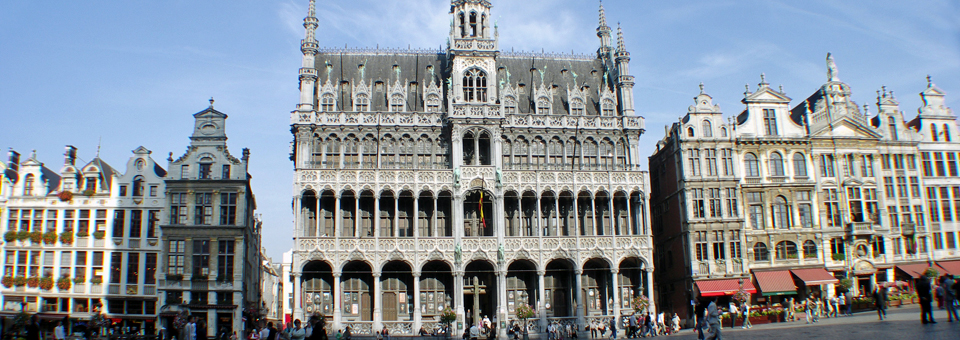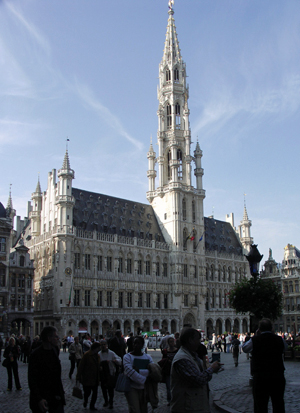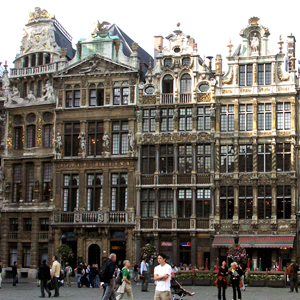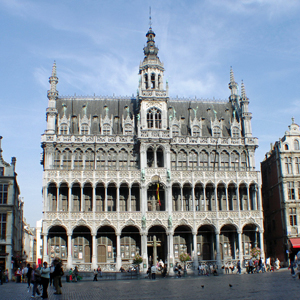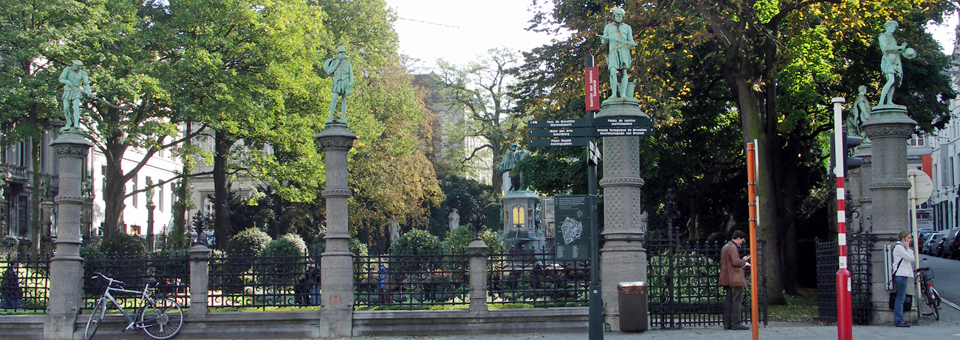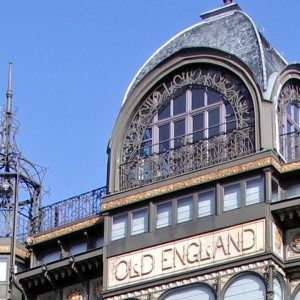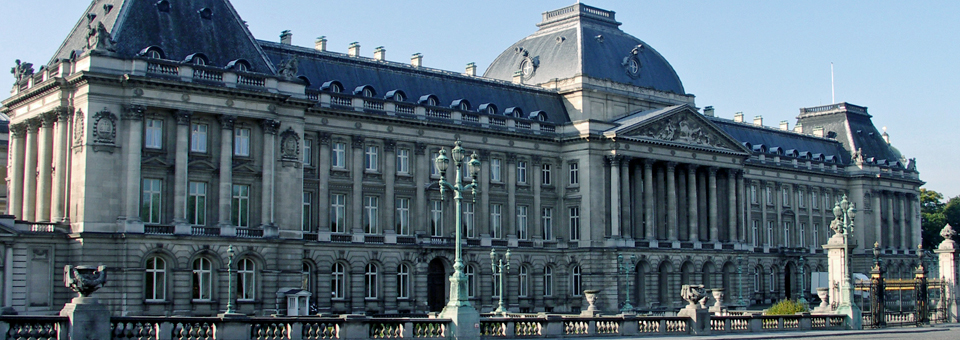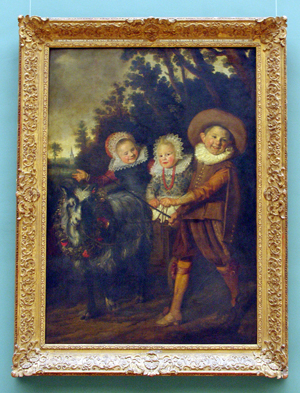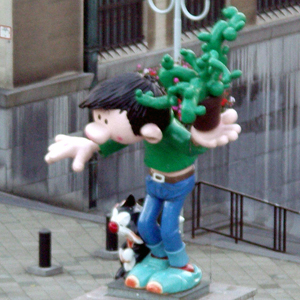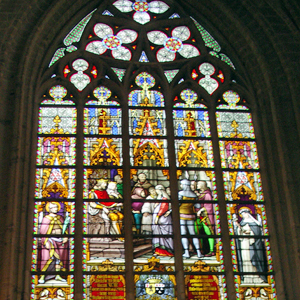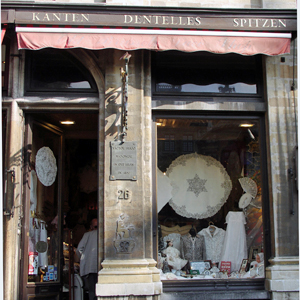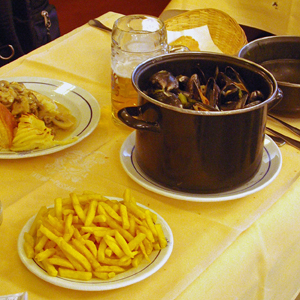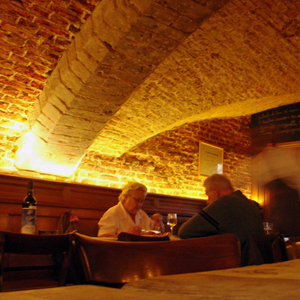Brussels
Belgium is a a kingdom about size of Maryland. We spent two glorious days in its capital, Brussels .
Getting around
Signs in Brussels are in two languages. Flemish, which is similar to Dutch, is the language of the Flemings in the north. French is the language of the Walloons in the south. English is widely spoken.
Most of the major sights of Brussels are within walking distance of one another. The Tourist Information Office, on the ground floor of Town Hall in Grand-Place, is the place to go for transportation and museum passes, maps, and help with planning your visit. If you’ll be visiting several museums, consider the Brussels Card, a 72-hour pass for admission to 30 museums, use of public transport, and discounts.
Top sights
Brussels is a melting pot, an international culture in a commercial, financial, and political center, best known as headquarters of NATO and administrative center of the European Union. The skyline is one of modern skyscrapers, but the heart of the city is in its historical center of glorious medieval buildings and impressive museums.
Brussels’ Lower Town, traditionally the poorer area of workers and immigrants, has narrow, winding streets and brick buildings. The wealthy and aristocratic resided in Upper Town, with its tree-lined wide boulevards, large public squares, mansions, and the palaces of 18th and 19th century.
The place to begin is Grand-Place (Grote Markt), built as a 13th century merchants’ center, and one of Europe’s most beautiful market squares. This cobblestoned UNESCO World Heritage site is dominated by the 315’ off-center spire of the intricate Gothic Town Hall (Hotel de Ville ), built in 1402, and one of the few original buildings not destroyed by Louis XIV’s cannons. If you take the tour of this building, don’t miss the art and tapestries of the Maximilian Room and the baroque Council Chamber.
The original wooden guild houses of Grand-Place were rebuilt in the 17th century in the elegant gabled and gilded Flemish Baroque style that stands today. In spring and summer, there’s a colorful flower market by day, and illumination of the facades by night.
Opposite Town Hall is King’s House (Maison du Roi), 1536, home of the Musée de la Ville de Bruxelles (City of Brussels Museum). Its collections include fine paintings, tapestries, silver, porcelain, and detailed scale models of the old historic city, but it is best known for its collection of over 800 costumes for the Mannekin Pis, donated by visiting heads of state. Follow the crowd from the Grand-Place to Petite Julien, better known as Mannekin Pis, a small bronze statue of a boy relieving himself into fountain, the best-known symbol of this city.
Browse the Place de Grand Sablon for upscale antique shops, art galleries, the weekend antiques market, and stylish restaurants in gabled mansions. Stop at Notre Dame du Sablon Church, founded in 1304 by the Guild of Crossbowmen, as their guild church.
You’ll recognize Place du Petit Sablon by the wrought iron fence with 48 bronze statues representing the medieval guilds.
Nearby is the Musée des Instruments Musique (Museum of Musical Instruments), in a beautifully renovated Art Nouveau building, formerly Old England shops. Infrared headphones bring you the sounds of instruments from around the world and throughout the centuries.
For a picnic, find a bench at Parc de Bruxelles, in front of the palace. The first shots in Belgium’s war of independence were fired here.
Walk to the Palace of Justice and on to the Place du Jeu-de-Balle for the daily Marche aux Puces (flea market) from 7am-2pm. There’s a public elevator at Palace of Justice, linking Upper and Lower Town.
If you have time for just one museum, choose the Musée aux des Beaux-Arts de Belgique (Royal Museums of Fine Arts of Belgium). Its Musée d’Art Ancien presents one of the world’s finest collections of 15th to 18th century Belgian and international painters in chronological order, including outstanding works by van der Weyden and van Eyck, Bruegel, Hals, and Rubens. The connected Musée d’Art Moderne has a floor plan that spirals downward from the 19th c. to the present, descending to collections by such artists as Matisse, Dali, Miro, Klee, Chagall, and, of course, Belgian Surrealist Rene Magritte.
Comic strips speak a universal language in this multicultural kingdom. Unique to Brussels is Centre Belge da la Band Dessinee (Belgian Center of Comic Strip Art), known locally as CéBéBéDé, with such cartoon characters as Tintin, Gaston Lagaffe, Smurfs, and Spiderman.
The Gothic Cathedral de St-Michel et Ste-Gudule, begun in the 13th century under the Duke of Brabant, was completed three centuries later by the Hapsburgs with the addition of magnificent Renaissance stained glass windows. A Gregorian choir performs on Sundays. Check the concert schedule. Photographs of royal weddings and funerals conducted here are in displayed near the entrance.
Belgium is renowned for tapestries, diamonds, and lace, but there are less costly shopping alternatives, like rich Belgian chocolate. Avenue Louise may be the fashionable place to be seen, but Rue Neuve is less expensive. For a more exotic shopping experience, try the street market with Arabic and Southern European influences at Place Bara near Gare du Midi on Sundays.
Dining out
Midday is a good time for a break, and lunches out tend to be half the cost of dinners. Menu refers to the plat du jour or dish of the day, a best buy. The Carte, or Kaart, lists other options. Grocery stores, bakeries, and sidewalk stalls are good sources of local specialties for a picnic in a scenic spot.
You must try one of the big pots of mosselen (mussels) in Brussels, and frites (fries), twice fried and crunchy, eaten with mayonnaise. Other specialties are tomates (shrimp stuffed tomatoes), anguilles au vert (eels in sauce), boudin (sausage) waterzooi (fish or chicken stew) and broodjes (baguettes with fillings). Buy gaufres, vanilla flavored waffles served with jam or an array of other toppings, from vendors around the Grand-Place. And don’t forget a stop at a chocolate shop for Belgian pralines!
There are hundreds of varieties of rich Belgian beers. Often flavored with fruits, there are brown, red, and white beers, Trappist ales brewed by monks, tart non-malted regional lambic types, and the champagne-like geuze, a blend of lambic beers. But beware—Belgian beer may contain up to 12% alcohol!
Three restaurants were recommended to us for traditional Belgian cuisine in and around Grand-Place. T’Kelderke, Grand Place 15, in the cellar of a guild house, was the recommendation of locals, and the scrumptious lunch special was the best buy around. Aux Armes de Bruxelles, 13 rue de Bouchers, is an exception on this street of tourist traps, family run, and has served such celebrities as Danny Devito and Laurel and Hardy. Taverne du Passage, an Art Deco brasserie in Galeries Royales St-Hubert, one of the oldest covered shopping malls in Europe, was a favorite of Surrealist painter Rene Magritte. Might this be the rack where he’d hang his bowler hat?
Outside the City
Take the bus or subway to venture beyond the petite ring encircling the city. Bus W goes to Waterloo, the site of the battle that ended Napoleon’s reign. Atomium, is a 335’nine-sphered model of an iron molecule, magnified 165 billion times, built for the 1958 Brussels World Fair. Visitors can walk inside the spheres and catch the view from the deck. It’s the site of Brupark!, a mini-Europe, 1/25 scale versions of Europe’s most famous buildings, an attraction befitting this multicultural center of Europe.

